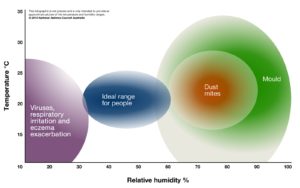
Factsheet
Indoor humidity levels
Indoor humidity levels can play an important role in your household’s health, particularly for people with asthma or allergies.
What is healthy humidity?
It is recommended to keep indoor relative humidity between 30 and 50 per cent, if possible. People typically find a relative humidity between 30 to 60 per cent most comfortable.
Relative humidity is a way of describing how much humidity (or water vapour) is in the air, compared to the maximum amount the air can hold at that temperature. Warm air can hold more water vapour than cold air.
High humidity
Condensation on your windows in the morning or a musty odour can be signs of high humidity in your home. High humidity levels provide an environment for two common asthma and allergy triggers: dust mites and mould.
Dust mites
Dust mites are one of the most common allergen triggers for asthma, especially in humid and coastal parts of Australia. They live in soft furnishings such as beds, bedding, carpets, upholstered furniture, soft toys and clothing.
Dust mites thrive in humidity levels at and above 70 per cent (particularly when combined with temperatures of 20-25 degrees Celsius). Testing demonstrates that lowering relative humidity to below 60 per cent can be effective in reducing dust mites.
Mould
Exposure to indoor and outdoor areas that are damp and have mould can trigger asthma or allergy symptoms in some people.
Humidity levels of 70 per cent are ideal for mould growth, though mould can grow at any level above 55 per cent.
Low humidity
Signs of low humidity in the home include dry, flaky paint on the walls, frequent static electricity, or eye, nose or throat dryness. Very dry air increases the chance of catching airborne viruses like a cold or the flu – possibly because they can survive longer in dry, cool conditions, and nasal irritation can make them easier to catch. Very dry air can make eczema worse and dry skin can be uncomfortable.
What you can do
- You can check the humidity in your home by using a hygrometer. These are sometimes included in thermometers or clocks.
- Ventilation and improved air circulation can be a cheap and effective method of reducing humidity, but if the humidity is higher outside than it is inside, just opening the windows is likely to increase indoor humidity.
- Heat recovery ventilation and other products that send warm air in ceiling cavities to cooler living areas should reduce relative humidity. A filter is a good idea if air is pumped into rooms.
- Use extraction fans in bathrooms and laundries, as hot showers and dryers can dramatically increase relative humidity. These areas are often prone to mould growth and extraction fans should be cleaned and maintained regularly.
- Refrigerated air conditioners often have built-in dehumidification functions that can be used to manage humidity levels.
- Dehumidifiers will extract water from the air and reduce humidity.
- Most forms of heating will lower relative humidity, but in some cases may cause air to become too dry. Avoid unflued gas heating and open fireplaces.
- Humidifiers may be suited to very dry indoor air but should not be set above 50 per cent relative humidity. They should include a feature to sterilise any mist they produce, so it does not spread bacteria, and turn off automatically once the desired humidity is reached.
- Except in very dry areas, avoid using an evaporative air-conditioner as it will increase humidity.


